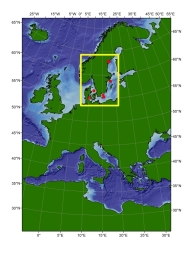Deployment: IODP-347
Description
IODP Expedition 347
Baltic Sea Basin Paleoenvironment
During Integrated Ocean Drilling Program Expedition 347, sediments from different settings in the Baltic Sea Basin (BSB) spanning the last glacial–interglacial cycles will be cored to address four main research themes:
- Climate and sea level dynamics of marine oxygen isotope Stage (MIS) 5,
including onsets and terminations,
- The complexities of the last glacial (MIS 4–MIS 2),
- Glacial and Holocene climate forcing (MIS 2–MIS 1), and
- Deep biosphere responses to glacial–interglacial cycles.
Addressing these themes will be accomplished by drilling in six subbasins: one in the gateway of the BSB (Anholt Loch), focusing on sediments from MIS 6–MIS 5 and MIS 2–MIS 1; a subbasin in the southwesternmost part of the BSB (Little Belt) that possibly retains a unique MIS 5 record; two subbasins in the south (Bornholm Basin and Hanö Bay) to target long complete records from MIS 4–MIS 2; and one deep (450 m) subbasin in the central Baltic Sea (Landsort Deep) that contains a thick and continuous record of the last ~14,000 y. Finally, the subbasin in the very north (Ångermanälven River estuary) contains a unique varved (annually deposited) sediment record of the last >10,000 y. These six areas contain a combined suite of sediment sequences encompassing the last ~140,000 y, with paleoenvironmental information on a semicontinental scale, as the Baltic Sea drains an area four times as large as the basin itself.
The location of the BSB in the heartland of the recurrently waning and waxing Scandinavian Ice Sheet (SIS) has resulted in a complex development history including repeated glaciations of different magnitude, sensitive responses to sea level and gateway threshold changes, large shifts in sedimentation patterns, and high sedimentation rates. Its position also makes it a unique link between Eurasian and northwest European terrestrial records. Therefore the sediments of this largest European intracontinental basin form a rare archive of climate evolution over the last glacial cycle. The high sedimentation rates provide an excellent opportunity to reconstruct climatic variability of global importance at a unique resolution from a marine-brackish setting in a location where comparable sequences from the surrounding onshore regions cannot be obtained.
Furthermore, the large variability (salinity, climate, sedimentation pattern, and oxygenation) that the BSB has undergone during the last glacial cycle makes it optimal for new research on the deep biosphere, addressing questions such as its evolution, its biogeochemical processes, and how the postglacial diffusive penetration of conservative seawater ions may alter the chemical composition and microbial physiology in the subseafloor biosphere.
Note: Drill site locations used for deployment locations table
| Dataset | Latest Version Date | Current State |
|---|---|---|
| Drill site locations from MPSV GREATSHIP MANISHA IODP-347 cruise in the Baltic Sea in 2013 (IODP-347 Microbial Quantification project) | 2016-03-24 | Final no updates expected |
| Quantitative PCR data from sediment samples from MPSV GREATSHIP MANISHA IODP-347 cruise in the Baltic Sea in 2013 (IODP-347 Microbial Quantification project) | 2016-03-25 | Final no updates expected |
People
Co-Chief Scientist: Dr Thomas Andrén
Södertörn University
Co-Chief Scientist: Dr Bo Barker Jørgensen
Aarhus University
Synonyms
• IODP Expedition 347

